| Programme of Study statement |
Activities |
| A |
B |
C |
D |
E |
| express missing number problems algebraically |
|
|
|
|
|
| use simple formulae expressed in words |
|
|
|
|
|
| generate and describe linear number sequences |
|
|
|
|
|
| find pairs of numbers that satisfy number sentences involving two unknowns |
|
|
|
|
|
| enumerate all possibilities of combinations of two variables. |
|
|
|
|
|
Activity A: Racetrack and Design a board game
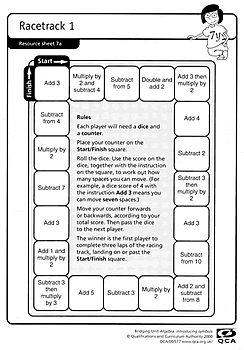
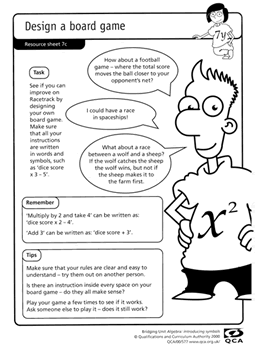
(Taken from Bridging units in mathematics – Algebra: introducing symbols, Qualifications and Curriculum Authority (QCA), 2000)
This pack of lesson materials (10 lessons for Y6 and 6 for Y7) was designed to support better continuity and progression in the learning and teaching of algebra between primary and secondary schools. The year 6 lessons contain the following themes: using function machines, notation and recording, generalising the results of an investigation and writing instructions using letters.
Activity B: Sticky Triangles
A puzzle in which match sticks are used to make a different number of triangles. An opportunity to generalise and symbolise.
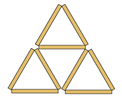
Activity C: This Pied Piper of Hamlyn
The ‘Pied Piper of Hamelin’ is a story you may have heard or read. This man, who is often dressed in very bright colours, drives the many rats out of town by his pipe playing - and the children follow his tune.
The challenge is to investigate how many children/rats there could be if the number of legs was 600.

Follow this link for a wealth of other NRICH activities where the focus is on finding all possibilities
Activity D: Generating Sequences
Say together the three times table: one three is three, two threes are six, … Ring the multiples 3, 6, 9, … up to 30 on the grid with a red pen as you say them.
Remind pupils that multiples of 3 are numbers that divide exactly by 3 and include the numbers in the three times table.
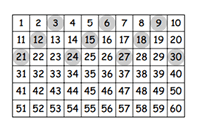
- Q Are the multiples of 3 odd or even? (they alternate)
- Q Can you describe the pattern the ringed numbers make? (sloping lines). How will it continue? (the sloping lines will extend across the grid)
- Q Will 36 be in the extended three times table? How do you know? Encourage pupils to look down the sloping lines of ringed numbers to judge whether 36 would be included. Repeat for 57 and 41.
Repeat this process for the four times table, marking them with a blue square. Draw out that all the multiples of 4 are even. This is taken from a series of four algebra lessons held on the National STEM Centre eLibrary.
The ‘Algebra 1’ lesson includes tasks on generating number sequences and describing them using formulae expressed in words.
N.B.You may wish to support the main activity of this lesson by using the ITP Number grid.
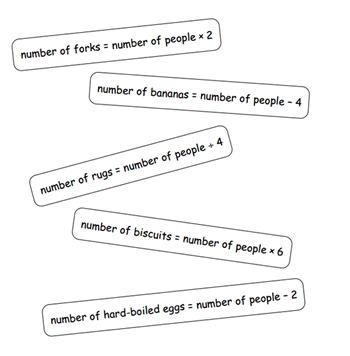
Ask:
- How many bananas are needed for 30 people going on a picnic?
- All 16 bananas were eaten at a picnic. How many people went?
- How many rugs are needed for 12 people on a picnic?
- 5 rugs were taken to a picnic. How many people went?
- How many biscuits are needed for 8 people for a picnic?
- 60 biscuits were packed for a picnic. How many people went?
- 12 hard-boiled eggs were packed for a picnic. How many people went?
The ‘Algebra 4’ lesson includes tasks on using formulae and solving simple equations










